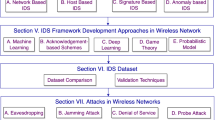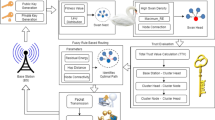Abstract
In wireless ad hoc network, all nodes participate for the transmission of data within the network and responsible for designing network topology. Suspicious and malicious activities can be detected by different techniques like IDS that is dynamic in nature. In clustering environment all the communication is carried out through cluster heads, we are having two cluster heads a primary cluster head (PCH) and secondary cluster heads (SCH) where SCHs communicate via PCH and if one of the secondary cluster head is compromised the entire network will be affected so malfunctioning of cluster head must be detected and identified. To handle this issue, we proposed a secure mechanism that provides security by minimum utilization of the resources after detection and identification the malicious Cluster Head. The proposed mechanism based on two level thresholds for the detection and identification of malicious cluster head that is dropping packets because of some attack. We used watchdog technique for initial monitoring. An agent is launched for detection and identification of the packets dropping problem. It is specially designed for secure UDP traffic transmission and fake report detection done by any of the malicious SCH to PCH.















Similar content being viewed by others
References
Tang, J., Cheng, Y., & Zhuang, W. (2014). Real-time misbehavior detection in IEEE 802.11-based wireless networks: An analytical approach. IEEE Transactions on Mobile Computing, 13(1), 146–158.
Tcholtcheu, N., & Schieferdecker, I. (2014). Framework for distributed autonomic self-healing in fixed IPv6 networks. International Journal of Communication Systems, 27(12), 4103–4125.
Lu, S. et al. (2006). Robust rate adaptation for 802.11 wireless networks. In Proceedings of the 12th annual international conference on mobile computing and networking (pp. 146–157). Los Angeles, CA.
Vishnu Balan, E., Priyan, M. K., Gokulnath, C., & Usha Devi, G. (2015). Hybrid architecture with misuse and anomaly detection techniques for wireless networl. In: This full-text paper was peer-reviewed and accepted to be presented at the IEEE ICCSP 2015 conference.
Urdaneta, G., Pierre, G., & van Steen, M. (2011). A survey of DHT security techniques. ACM Computing Surveys, 43, 2. https://doi.org/10.1145/1883612.1883615.
Li, G. Y. (2015). Adaptive and opportunistic QoS-based routing protocol in VANETs. Networking and Internet Architecture [cs.NI]. Université Paris Sud - Paris XI, English.
Bradley, K. A.et. al. (1998). Detecting disruptive routers: A distributed network monitoring approach. In Proc. 1998 symposium on security and privacy (pp. 115–124).
Hadjiantonis, A. M., & Ellinas, G. (2010). In 2010 Fourth IEEE international conference on towards autonomic wireless networking for the future internet self-adaptive and self-organizing systems workshop (SASOW).
Chang, J. M., Tsou, P. C., Woungang, I., Chao, H. C. & Lai, C. F. (2015). Defending against collaborative attacks by malicious nodes in MANETs: A cooperative bait detection approach. IEEE Systems Journal, 9(1), 65–75.
Butun, I., Morgera, S. D., & Sankar, R. (2014). A survey of intrusion detection systems in wireless sensor networks. IEEE Communications Surveys & Tutorials, 16(1), 266–282.
Doumit, S., et.al. (2003). Self-organized criticality and stochastic learning based intrusion detection system for wireless sensor networks. In MILCOM 2003 (pp. 609–614).
Karlof, C., et.al. (2004). TinySec: A link layer security architecture for wireless sensor networks. In ACM Sensys 2004 Proceedings. (pp.162–175). Baltimore, USA.
Buchegger, S. (2004). Coping with misbehavior in mobile ad hoc networks. PhD Thesis EPFL No. 2935. Accepted Feb 2004.
Kalambe, K. B., & Apte, S. M. (2017). An exhaustive survey on security solutions in MANETS (pp. 124–131).
Zhou, J., Dong, X., Cao, Z., & Vasilakos, A. V. (2015). Secure and privacy preserving protocol for cloud-based vehicular DTNs. IEEE Transactions on Information Forensics and Security, 10(6), 1299–1314.
Albouq, S. S., & Fredericks, E. M. (2017). Lightweight detection and isolation of black hole attacks in connected vehicles. In 2017 IEEE 37th international conference on distributed computing systems workshops (ICDCSW). IEEE.
Kasra-Kermanshahi, S., & Salleh, M. (2015). A novel authentication scheme for mobile environments in the context of elliptic curve cryptography. In Computer, communications, and control technology (I4CT), 2015
Minematsu, K. (2016). Authenticated encryption with small stretch (or, how to accelerate aero). In Australasian Conference on Information Security and Privacy (pp. 347–362). Springer, Cham.
Cho, K., Jo, M., Kwon, T., & Chen, H. H. (2013). Classification and experimental analysis for clone detection approaches in wireless sensor networks. IEEE Systems Journal, 7(1), 26–35.
Mejri, M. N., Ben-Othman, J., & Hamdi, M. (2014). Survey on VANET security challenges and possible cryptographic solutions. Vehicular Communications, 1, 53–66.
Du, W. et al. (2005). LAD: Localization anomaly detection for wireless sensor networks. In the 19th international parallel and distributed processing symposium (IPDPS’05), April 3–8, 2005, Denver, Colorado, USA
Baadache, A., & Belmehdi, A. (2014). Struggling against simple and cooperative black hole attacks in multi-hop wireless ad hoc networks. Computer Networks, 73(14), 173–184.
Biagioni, E. (2016). Distributed anonymous computation of social distance. Department of Information and Computer Sciences, University of Hawaii at M¯anoa, Honolulu, Hawaii, USA 2016.
Nadeem, A., & Howarth, M. P. (2014). An intrusion detection & adaptive response mechanism for MANETs. Ad Hoc Networks, 13(Part B), 368–380.
Venkanna, U., Agarwal, J. K., & Velusamy, R. L. (2015). A cooperative routing for MANET based on distributed trust and energy management. Wireless Personal Communications, 81(3), 961–979.
Maheswara Rao, A., Varadarajan, S., & Giri Prasad, M. N. (2012) Cross-Layer Based QoS Routing (CLBQR) Protocol analysis based on data flow for 802.16 WiMAX Networks Communication and Computing (ARTCom2012). In Fourth international conference on advances in recent technologies in 2012.
Krishna, S. R. M., Prasad, P. V. K., Ramanath, M. N. S., & Kumari, B. M. (2015) Security in MANET routing tables with FMNK cryptography model. In 2015 International electrical, electronics, signals, communication and optimization (EESCO).
Author information
Authors and Affiliations
Corresponding author
Additional information
Publisher's Note
Springer Nature remains neutral with regard to jurisdictional claims in published maps and institutional affiliations.
Rights and permissions
About this article
Cite this article
Ismail, A., Amin, R. Malicious Cluster Head Detection Mechanism in Wireless Sensor Networks. Wireless Pers Commun 108, 2117–2135 (2019). https://doi.org/10.1007/s11277-019-06512-w
Published:
Issue Date:
DOI: https://doi.org/10.1007/s11277-019-06512-w




